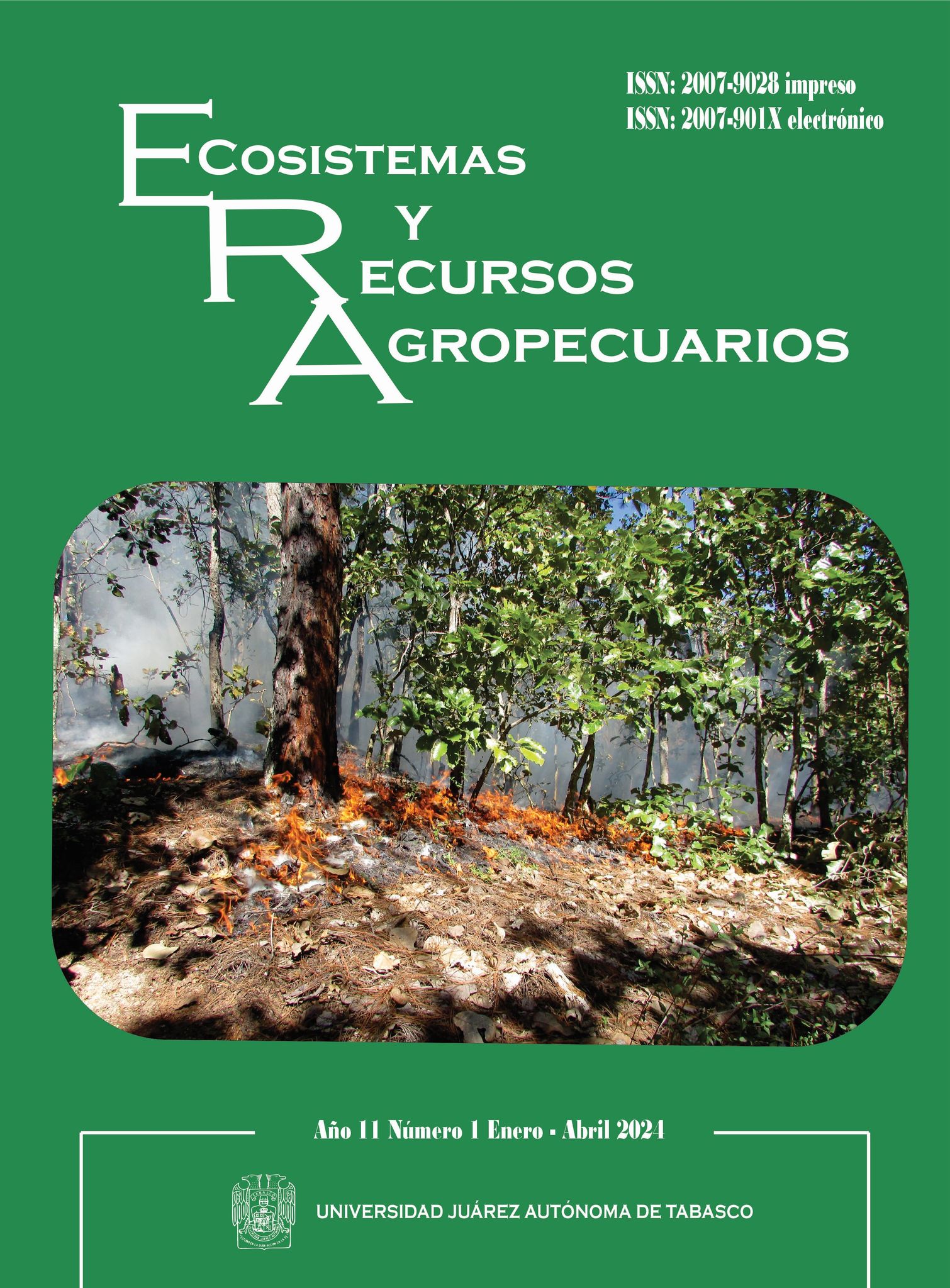New record of the genus Isonychia (Ephemeroptera: Isonychiidae) in Mexico and water parameters data
DOI:
https://doi.org/10.19136/era.a11n1.3941Keywords:
Distribution, Durango, Isonychiidae, environmental factors, Nazas RiverAbstract
The genus Isonychia groups mayflies with large nymphs present in lotic ecosystems. This genus has a very wide distribution, despite of this, in Mexico the records are very scarce and these do not refer to the environmental characteristics of the sites where they were found. The objective of this work is to report for the first time the genus Isonychia in Durango state, as well as to characterize some physicochemical parameters of water associated with its distribution. A total of 19 Isonychia nymphs, which probably correspond to the species I. sicca, were recorded in seven sites within the Nazas River basin. This extends the distribution range of the genus Isonychia for Mexico. The specimens were recorded in environments with moderate current speed and an acceptable water quality compared to other riparian systems, in terms of dissolved oxygen, electrical conductivity, total dissolved solids, pH, temperature and ammonium.
Downloads
References
Adjovu GE, Stephen H, Ahmad S (2023) Spatiotemporal Variability in Total Dissolved Solids and Total Suspended Solids along the Colorado River. Hydrology 10: 125. https://doi.org/10.3390/hydrology10060125.
Bahuguna P, Dobriyal AK (2018) First report on the occurrence of some benthic macroinvertebrates in the spring-fed streams of Garhwal Himalaya, India. International Journal of Research and Analytical Research and Analytical Reviews 5: 437-443.
Barber-James H, Sartori M, Gattolliat JL, Webb J (2013) World checklist of freshwater Ephemeroptera species. Freshwater Animal Diversity Assessment. http://fada.biodiversity.be/group/show/35. Fecha de consulta: 20 de julio de 2023.
Castillo MM, Barba-Álvarez R, Mayorga A (2018) Riqueza y diversidad de insectos acuáticos en la cuenca del río Usumacinta en México. Revista Mexicana de Biodiversidad 89: 45-64. https://doi.org/10.22201/ib.20078706e.2018.0.2177.
Camp AA, Buchwalter DB (2016) Can´t take the heat: Temperature-enhanced toxicity in the mayfly Isonychia bicolor exposed to the neonicotinoid insecticide imidacloprid. Aquatic Toxicology 178: 49-57. https://doi.org/10.1016/j.aquatox.2016.07.011.
Cerano-Paredes J, Villanueva-Díaz J, Valdez-Cepeda RD, Constante-García V, González-Barrios JL, Estrada-Ávalos J (2012) Precipitación reconstruida para la parte alta de la Cuenca del Río Nazas, Durango. Revista Mexicana de Ciencias Forestales 3: 7-23. https://doi.org/10.29298/rmcf.v3i10.525.
Fernández-Cirelli A (2012) El agua: un recurso esencial. Química Viva 11: 147-170.
GBIF (2023) GBIF Backbone taxonomy. Global Biodiversity Information Facility Secretariat. https://doi.org/10.15468/39omei. Fecha de consulta: 20 de julio de 2023.
Kondratieff BC, Voshell JR (1984) The North and Central American species of Isonychia (Ephemeroptera: Oligoneuriidae). Transactions of the American Entomological Society 110: 129-244.
Leija EG, Valenzuela-Ceballos SI, Valencia-Castro M, Jiménez-González G, Castañeda-Gaytán G, Reyes-Hernández H, Mendoza ME (2020) Análisis de cambio en la cobertura vegetal y uso del suelo en la región centro-norte de México. El caso de la cuenca baja del río Nazas. Ecosistemas 29: 1826-1826. https://doi.org/10.7818/ECOS.1826.
McCafferty WP, Provonsha AV, Wang TQ (1997) Los efemerópteros de México: I. clasificación superior, diagnosis de familias y composición. Dugesiana 4: 1-29. https://doi.org/10.32870/dugesiana.v4i2.7192.
Muthukatturaja M, Balasubramanian C, Rathinakumar T, Sivaramakrishnan KG (2021) A new species of Isonychia Eaton, 1871 (Ephemeroptera: Isonychiidae) from Kapila River, Central Western Ghats, India. Zootaxa 4908: 283-291. https://doi.org/10.11646/ZOOTAXA.4908.2.9.
Ramírez A (2010) Capítulo 2: Métodos de recolección. Revista de Biología Tropical 58: 41-50.
Randolph RP, McCafferty WP (2000) Mexican mayflies: inventory and additions (Ephemeroptera). In Annales de Limnologie-International Journal of Limnology 36: 113-121. https://doi.org/10.1051/limn/2000007.
Saito R, Jo J, Sekiné K, Bae YJ, Tojo K (2016) Phylogenetic analyses of the isonychiid mayflies (Ephemeroptera: Isonychiidae) in the northeast palearctic region. Entomological Research 46: 246-259. https://doi.org/10.1111/1748-5967.12168.
Saito R, Jo J (2021) Variation in respiratory rate and gill morphology in different genetic lineages of Isonychia japonica Ulmer, 1919 (Ephemeroptera: Isonychiidae). Aquatic Insects 43: 30-40. https://doi.org/10.1080/01650424.2021.1942495.
Sartori M, Brittain JE (2015) Order Ephemeroptera. In: Thorp JH, Covich AP (ed) Thorp and Covich’s freshwater invertebrates. Elsevier Inc. London, UK. pp: 873-891. https://doi.org/10.1016/B978-0-12-385026-3.00034-6.
Sierra-Ramírez CA (2011) Calidad del agua: evaluación y diagnóstico. Ediciones de la U. Universidad de Medellín. Medellín, Colombia. 457p.
Voshell JR (2007) A guide to common freshwater invertebrates of North America. McDonald & Woodward Publishing Company. Blacksburg, Virginia, USA. 442p.
Vasanth M, Selvakumar C, Subramanian KA, Babu R, Sivaramakrishnan KG (2019) A new record of the family Isonychiidae (Insecta: Ephemeroptera) from the Western Ghats, India with a description of new species. Zootaxa 4586: 162p. https://doi.org/10.11646/ZOOTAXA.4586.1.9.
Downloads
Published
Issue
Section
License
Copyright (c) 2024 Ecosistemas y Recursos Agropecuarios

This work is licensed under a Creative Commons Attribution-NonCommercial-ShareAlike 4.0 International License.
Aviso de copyright
Los autores que se envían a esta revista aceptan los siguientes términos:
una. Los autores conservan los derechos de autor y garantizan a la revista el derecho a ser la primera publicación del trabajo con una licencia de atribución de Creative Commons que permite a otros compartir el trabajo con un reconocimiento de la autoría del trabajo y la publicación inicial en esta revista.
B. Los autores pueden establecer acuerdos complementarios separados para la distribución no exclusiva de la versión del trabajo publicado en la revista (por ejemplo, en un repositorio institucional o publicarlo en un libro), con un reconocimiento de su publicación inicial en esta revista.
C. Se permite y se anima a los autores a difundir su trabajo electrónicamente (por ejemplo, en repositorios institucionales o en su propio sitio web) antes y durante el proceso de envío, ya que puede conducir a intercambios productivos, así como a una cita más temprana y más extensa del trabajo publicado. (Consulte El efecto del acceso abierto).


